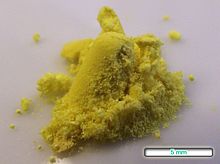Nifedipine
chemical compound
Nifedipine (brand names: Adalat, Adipine, Coracten, Fortipine, Nifedipress) is a calcium channel blocker medicine used to treat high blood pressure (hypertension).[3]
 | |||
| |||
| Clinical data | |||
|---|---|---|---|
| Trade names | Adalat, Procardia, others | ||
| AHFS/Drugs.com | Monograph | ||
| MedlinePlus | a684028 | ||
| License data |
| ||
| Pregnancy category |
| ||
| Routes of administration | By mouth, topical | ||
| Drug class | Calcium channel blocker (dihydropyridine)[2] | ||
| ATC code | |||
| Pharmacokinetic data | |||
| Bioavailability | 45-56% | ||
| Protein binding | 92-98% | ||
| Metabolism | Gastrointestinal, Liver | ||
| Elimination half-life | 2 hours | ||
| Excretion | Kidneys: >50%, bile duct: 5-15% | ||
| Identifiers | |||
| CAS Number | |||
| PubChem CID | |||
| IUPHAR/BPS | |||
| DrugBank | |||
| ChemSpider | |||
| UNII | |||
| KEGG | |||
| ChEBI | |||
| ChEMBL | |||
| ECHA InfoCard | 100.040.529 | ||
| (verify) | |||
In people with high blood pressure, taking nifedipine helps to prevent future heart disease, heart attacks and strokes.[3] Nifedipine is also used to prevent chest pain caused by angina. Occasionally, it is used to treat Raynaud's phenomenon and chilblains.[3]
Related pages
changeReferences
change- ↑ "Nifedipine Pregnancy and Breastfeeding Warnings". Archived from the original on 21 December 2015. Retrieved 25 December 2015.
- ↑ "Nifedipine". The American Society of Health-System Pharmacists. Archived from the original on 8 August 2018. Retrieved 17 September 2019.
- ↑ 3.0 3.1 3.2 "About nifedipine". nhs.uk. 2022-02-25. Retrieved 2024-05-30.

